by Eric Meier
Brief disclaimer: In writing this article, I am in no way stating that any particular wood is “bad” or of low quality. In this age of phenolic fakes, MDF, OSB, LVL, and other abbreviated products, real, solid wood is to be appreciated. However, my purpose in composing this list is to simply highlight ways in which woodworkers have perhaps overly valued certain wood species.
|
|
||
 |
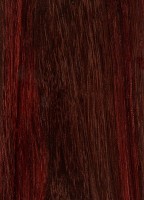 |
Bois de Rose(Dalbergia maritima) Why people love it: This true rosewood is a rich, eggplant purple. Why it’s overrated: Like a flower, Bois de Rose’s beauty fades, and the wood turns very dark purple, to nearly black. And the fact that it’s also an endangered species, and the flashpoint for illegal logging in Madagascar is only icing on the cake. Try this instead: Purple colors in wood simply don’t last. Use dyes instead, and you’ll never be sorry. |
|
|
||
 |
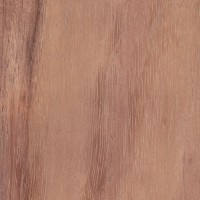 |
Koa
|
|
|
||
 |
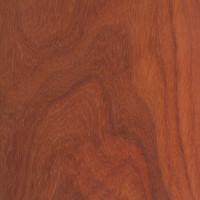 |
African Padauk(Pterocarpus soyauxii) Why people love it: Rich reddish orange color and good workability. Why it’s overrated: Much like other colorful woods, Padauk’s color doesn’t last, and turns a dark brown over time. Try this instead: Find a nicely colored piece of the more color-stable Chakte Viga, or just use dyes. |
|
|
||
 |
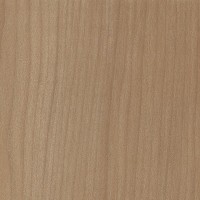 |
Ancient Kauri(Agathis australis) Why people love it: Pulled up from bogs in New Zealand, Kauri is thousands of years old, making it the oldest wood on the market. Why it’s overrated: When you get past the novelty, it’s basically just an old-growth softwood. True, there are some nice figured pieces, but on the whole, not worth the exorbitant costs over, say, Douglas Fir. Try this instead: For huge tabletop slabs, waterfall Bubinga or curly Claro Walnut have a lot more visual interest. |
|
|
||
 |
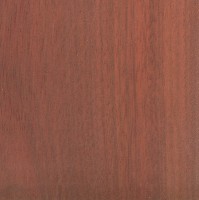 |
Bloodwood(Brosimum rubescens) Why people love it: The startling red color makes the wood true to its name. Why it’s overrated: Much like other colorful woods, Bloodwood’s color doesn’t last, and turns a dark brown over time. It’s also horrific in workability, being extremely dense, blunting sharp cutters, and splintering easily. Try this instead: If you want a wood that will truly stay vibrant red, use maple. And red dye. |
|
|
||
 |
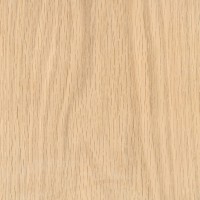 |
Oak(Quercus spp.) Why people love it: Abundant, economical, easy to work, visually interesting grain lines, and solid strength characteristics. Why it’s overrated: This wood is everywhere. I’m typing this at a desk made of oak. The cabinets in the office are oak. The door and trim in the room are oak. The wood has become so commonplace, people simply don’t even see it anymore. It simply becomes generic “wood.” Try this instead: Something… anything. Break out of the ordinary. Quartersawn Sycamore is a visually interesting domestic hardwood that’s under-utilized. |
|
|
||
 |
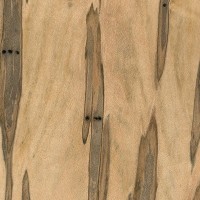 |
Ambrosia Maple(Acer spp.) Why people love it: The dark streaks contrast well against the lighter colored maple sapwood. Why it’s overrated: This color is not natural, it’s from beetles that infest and bore into the tree, leaving a series of holes in the wood itself, bringing in fungus that discolors the wood. For those creepy types that keep pet tarantulas, this should warm your heart; for the rest of us, it’s disgusting. Try this instead: Goncalo Alves, or have a look at other striped woods. |
|
|
||
 |
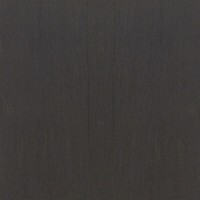 |
Ebony(Diospyros spp.) Why people love it: It’s pitch-black. Why it’s overrated: The highest grades of ebony are totally black, with no discernible grain patterns, ironically resembling black plastic. (And most laypeople/customers unfamiliar with ebony have no appreciation for this expensive and endangered wood.) Try this instead: Katalox. Or, for something that might actually be taken for real wood and not plastic, Black Palm, Pheasantwood, or Wenge. |
|
|
||
 |
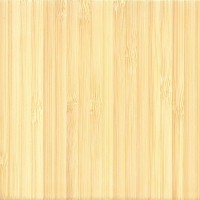 |
Bamboo(Bambusa spp.) Why people love it: Currently riding a wave of popularity, bamboo is fast-growing and eco-friendly. It says, “I love old barns, owls, and other all-natural, outdoorsy stuff.” Why it’s overrated: This isn’t real wood, and bamboo is technically not a “tree,” but is in the Poaceae (grass) family. Hundreds of small strips of bamboo material are machined and glued together, making quasi-boards. Sustainable? Yes. Natural? Hardly. Try this instead: Real wood. It has character, uniqueness (two different boards actually look… different), and isn’t a series of tiny processed shards held together with glue. |
|
|
||
 |
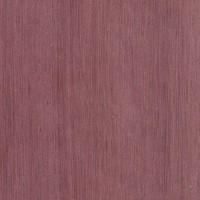 |
Purpleheart
|
|
|
||
See also:
Are you an aspiring wood nerd?
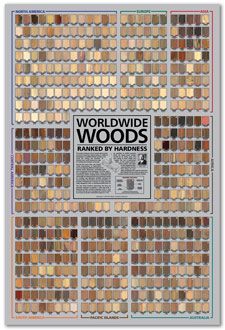 The poster, Worldwide Woods, Ranked by Hardness, should be required reading for anyone enrolled in the school of wood nerdery. I have amassed over 500 wood species on a single poster, arranged into eight major geographic regions, with each wood sorted and ranked according to its Janka hardness. Each wood has been meticulously documented and photographed, listed with its Janka hardness value (in lbf) and geographic and global hardness rankings. Consider this: the venerable Red Oak (Quercus rubra) sits at only #33 in North America and #278 worldwide for hardness! Aspiring wood nerds be advised: your syllabus may be calling for Worldwide Woods as part of your next assignment!
The poster, Worldwide Woods, Ranked by Hardness, should be required reading for anyone enrolled in the school of wood nerdery. I have amassed over 500 wood species on a single poster, arranged into eight major geographic regions, with each wood sorted and ranked according to its Janka hardness. Each wood has been meticulously documented and photographed, listed with its Janka hardness value (in lbf) and geographic and global hardness rankings. Consider this: the venerable Red Oak (Quercus rubra) sits at only #33 in North America and #278 worldwide for hardness! Aspiring wood nerds be advised: your syllabus may be calling for Worldwide Woods as part of your next assignment!




Hi Eric,
I enjoy reading your articles, but I disagree with the method of determining whether a wood type is overrated or not worth it without a common standard for evaluation. Without such a standard, it’s impossible to achieve a fair result.
For instance, consider the Mona Lisa—would you call it an overrated painting or just a child’s drawing? How would you rate the painting itself without considering its heritage or cultural significance?
Just sharing my two cents. I do appreciate your work here—great insights as always.
Best regards
John
I built an acoustic guitar back in 1979 and used some very black ebony for the bridge, fretboard, and laminate headstock, and clear lacquer finish. Comments were; “Gary, such a fine guitar, why did you use plastic for the bridge?”
I would argue that black plastic and Ebony look nothing alike. But I believe the reference is towards the average person who thinks all woods they see are the same thing. Also, many points for your trashing Oak and recommending Sycamore. I hate oak and it is EVERYWHERE. Sycamore is one of the most unique woods in America and I can’t get enough of it.
It’s just not fair calling Ebony overrated because it’s super black and looks like plastic. Actually that’s why I love it!
Purple Heart wood will just turn a deep brown over time. Although my personal favorite is African padauk wood. I like this wood for wood shop because it is a really nice orangey red look, it is also a decent hard wood.
I have been searching for a finish that will preserve the color in the very woods that you mention here, and am currently testing the exterior varnish Epifanes, made primarily for marine applications. In a year-long study by Fine Woodworking magazine, Epifanes beat all other exterior finishes in a test for the preservation of various wood samples left 0outside under harsh conditions. This finish has UV blockers to preserve color. It is applied by brush, is quite viscous, and dries with a thick, high gloss coat. I have used it on tulipwood, camatillo (Mexican kingwood), and Madagascar rosewood (bois de… Read more »
Very nice turnings! I think the epiphanes is probably the best choice for UV protection, but I don’t think it will be a cure-all or silver bullet. Have you seen this article? https://www.wood-database.com/wood-articles/preventing-color-changes-in-exotic-woods/
I built projects out of purple heart and padauk 10, 15, and 20 years ago. The colors do evolve, like every wood on the planet changes over time, but the purple is certainly still there, as is the red. They’ve become more complex and interesting and more beautiful in my opinion. The color was only one of many aspects of why the wood was chosen, strength, wear resistance, porosity, dimensional stability, weather proof, weight, and feel are all parts of the wood selection process. Not much will match Purple Heart in several of these categories. So I find your list… Read more »
Hi, Absolutely fascinating! Ordering your book today.
I’m now wondering what type of wood some of the dressers are made of.
Attached are the pictures with each set obtained years apart. The first set have silvered mirrors. I got them from a SC antique dealer I’d known for years (they were refinished by a pro ~~2001. Second set down in Virginia ~2006.
Thank You,
Anony?
Hard to tell from the pics as it doesn’t appear to be a natural wood color (it’s been stained). If you could possibly contact the refinisher, I’m sure they would have a better idea. Otherwise, my best guess would be some quartersawn mahogany veneer that’s been stained a more reddish brown color.
One problem I have come across, is that bamboo is very attractive to powder post beetles. It has a high carbohydrate residual left in the “material” to feed the buggers.If your older home has had beetle issues, this may not be a good choice for flooring.
Okay, i love this website. However, bamboo is wood. Calling bamboo a grass and not a tree because its in the “grass” family is like saying locust isn’t a tree because its a member of the legume family. Wood is the hard part of plants that are not herbaceous. Just because it isn’t a hardwood or a softwood does not mean it isn’t wood. Just like palm wood, bamboo is the hard part of a monocot plant. In fact, bamboo has more in common with hardwoods than softwoods do. I agree that its structure makes it very illogical to use… Read more »
amazing stuff guys we need to get a pertition going to stop people from identifying bamboo as a wood/tree.
Definitely disagree with ambrosia maple. It has its time and place. I do feel like it is misused a lot, but that is not the same as overrated.
Much like the Ambrosia Maple I’ve seen cabinets made from the wood of tapped sugar maples, same fungus staining but with the nickel sized tap holes also. Over time the tree fills in the holes with new wood giving unique shapes. You said you don’t like oak.
Wenge and katalox are kind of cheap looking substitutes for ebony. Ebony for large items is a bit presumptuous, but the real treat with it is its ability to be uniformly dark and take great detail carving, chiseling or scraping.
It’s sort of like mahogany for guitars. Lots of other woods make a decent guitar. Honduran mahogany is more stable, shrinks less and works nicer than any of them.
There’s nothing like an ebony fretboard for an electric guitar or bass.
Tasmanian Blackwood really is stunning, golden browns through to dark chocolate and often shows “flame” patterns. For a red colored wood that stays red check out River Red Gum, also an Aussie. (Under a finish/varnish, it’s usually a deep burgundy red, but the color lasts, we have a Red Gum coffee table over 20 years old and it’s still its original deep wine red.)
At least in the lutherie world koa was initially used as a substitute for figured mahogany. Honduras mahogany is occasionally seen with maple-like curl, birdseye, “quilt,” and “flame,” and until the late 1960’s much of the imported material had such figure and went into custom guitars and other stringed instruments. It apparently takes an old tree to yield figured sets, and old Honduras mahogany trees are long gone. As the supply of figured mahogany dried up, luthiers and others sought a substitute. Koa popped up–its grain is strikingly similar to mahogany, much of it is highly figurted, and back then… Read more »
Can anyone identify this wood??
English oak? (Had a sideboard at home with similar grain patterns)
Looks like fir to me.
Agreed–Douglas fir plywood
rotary peeled douglas fir
It’s southern yellow pine plywood. Fairly easy to tell from the grain pattern which was peeled to make the plywood. You can also tell from the lack of stain absorption in the late wood & unevenly sanded surface which is very common in SWP because of the huge variation in densities between the late wood & early wood. I’ve seen it a million times.
When you blow up the picture you can tell it’s plywood, the edge shows it well. Yes also believe it to be fir plywood.
I made a kleenex box holder out of beautiful purpleheart with a wavy figure back in the 1980s. The color looks great! Just don’t set it in the direct sun. That’s just common sense.
I had a Red Flowering Quince bush in my yard, a long, long time, over 60 years. It finally died, and I found that the wood has very nice color and grain so close it almost looks like it does not have any grain. Very hard wood I have a friend who is craving knife handles using this wood. He had never heard of it but really likes and wants more. Just wanted to share – you never know what you might find in your own yard. Gayle, Manteca CA
No listing here (apparently) of the Australian native Lilly Pilly (Syzgium Smithii).
The timber from trees that can grow to 30 mtrs is sometimes used for floor boards.
If any details re strength, insect & moisture resistance, & availability please publish.
What can you tell me about a Peruvian ( I believe) wood called Aripari.
Don’t have too much info available at the moment. Scientific name is Macrolobium acacifolium. I have a sample but have not yet added it to the site. It appears to be of medium density with a hardness roughly equivalent to oak.
G’day Eric , I’m wondering why Gidgee , Acacia cambagei doesn’t make you top ten for density ? Fairbairn states the density at 1283 kg/m though I have tested samples out to 1350
Love your work
Pete
Curly timbers
I am a custom cue maker. I dearly love Purple Heart. When it is first exposed to the light it almost a light brown but soon darkens to a burgundy color. When paired with something like tulipwood which is like a yellowish tan with purple grain it is absolutely beautiful
Ebony and various rosewoods have a long history of being used for guitar fretboards, and koa has more recently been finding its way on acoustic guitars. Part of koa’s appeal in this case is admittedly appearance, though that’s mostly seen as a bonus to its qualities as a tonewood.
On the other hand, ebony seems to have lost favor to African blackwood in woodwinds due to workability. At any rate, discussion of alternatives to traditional tonewoods seems to me to be a worthwhile inclusion.
Eric, you’re hilarious. Is there a list of articles you’ve written somewhere? I want to read them all.
Hoi, leave the oak alone :-) I live next to Oakland Road (translated) here in Norway, so I am biased!
But the variety in patterns and colour in Norwegian oaks is really fascinating. If we need straight-grown oak we have to go to Denmark or further down the continent. But as interesting wood, our oak is ‘top drawer’.
I agree with you to some extent. Oak has be used so much that to many people it is just regarded as plain old wood, but so is this the case with many exotic woods many people have never heard of. I once showed a fellow woodworker my Mopane pen and he asked what kind of mahogany or sapele it was. However I have came across a variety of oak boards that I will say look more interesting that figured exotics, especially when exhibiting burls or medullary ray patters which are more common in oak due to the way it… Read more »
Is it wrong of me that I actually prefer the old faded look of padauk? I cant get many other woods in my area that match that color. The orange color I find garish but that lovely chocolate brown is amazing in my opinion.
Oh gosh I love this! Hahaha. Some of these I’ve not heard of but I’m kind of a new wood worker. Honestly I think mahogany is underrated at leat among my hardcore wood buddies. It’s actually pretty soft compared to uhh some of these and I find it easy to work with as new beginner. I know it isn’t on this lis but some of the comments suggested it should be so this is more of a response to those. Not sure how it holds up over time though. Instead of ebony why not try persimmon? It’s white ebony. and… Read more »
Nice Post
I agree with that we can you oak in everywhere
in home. Oak is one of the most popular styles in wood flooring
because engineered oak floors are great alternative of real wood floors. Oak
flooring offer excellent protection and an easily maintainable finish.
Keep Posting…….
Thanks
Ambrosia maple should come off the list since it’s unswappable. When I put my toys in a line to show them off, whether it’s select unfinished canarywood or even select finished bloodwood (even best colors, people), they always point to the ambrosia. Vastly underrated in all respects. Most people have never even seen it before.
I agree that using ebony raises some questions, mainly regarding ethical issues, but unless it is buried ten layers deep in polyurethane, it doesn’t look like plastic at all. And “customers” may not be familiar with it most of the time, but in the musical instrument business, customers are familiar with everything, and these customers are the most finicky there are. Gibson did use plastic on some of their guitars, after the government raided their illegal wood stock, to the outrage of their customers.
I call them overrated, but not ugly. I think that for most people, their automatic perception when they buy/make something out of wood is that, cared for properly, it will continue to look more or less the same over the years. Having mahogany or cherry patina over time is one thing, but for a wood species to turn from purple (or orange, or red) to brown is something else entirely. To me, that’s an example of over-inflated expectations, hence the label “overrated.” Many of these woods are quality woods in their own right (Padauk is very stable and easy to… Read more »
I’m sitting here looking at a project box I made for my wife out of curly maple with a padauk lid insert. Between the grain and the color in the padauk, it looks like little flames flickering over the surface of the wood. One of the most interesting combinations I’ve ever seen. I agree that I could probably duplicate the basic coloring of the padauk with dyes. But do you have a recommendation for a wood with similar grain structure to receive the dye to replace the padauk?
Inlaid wood is tough because it’s hard to sand dyed wood without sanding through the dye layer.
As far as grain structure, it sounds like you are referring to flatsawn wood, which can look somewhat flame-like. If hardness isn’t a huge issue, it might be interesting to try dyeing some flatsawn softwoods, such as Douglas Fir or southern yellow pine, and see how that turns out. Otherwise, there’s a lot of light-colored hardwoods that you could use flatsawn for that grain pattern, such as Hard Maple.
New Guinea Rosewood is great. Plentiful, and cheap for the quality.
any suggestion on type of woods available worldwide for manufacturing Rotary cut commercial veneer for Indian Market please? (Apart from Gurjan @ Keruing- dipterocarpus )
Sycamore? Have you ever worked Sycamore? More correctly, have you ever tried to keep Sycamore straight? It is very unstable, although it has an interesting grain.
I have indeed worked with Sycamore. I’ve seen where it may be tough to initially dry (which is moot as I would just buy it kiln dried anyway) but once it has dried, it seems to be of about average stability — probably better than oak.
Secondly, I was referring specifically to quartersawn sycamore, which should be more stable than flatsawn stock. If anything, I’d say the main drawback of Sycamore is its softness.
There seems to be so much hate out there for Sycamore. I’ve air dried a lot of it in stacks and it seems to stay pretty straight once it’s been liberated. I love this wood, especially the quartersawn stuff. Keep it out of the bathtub and you’ll be fine!
Comparing Kauri to Pine and Dug Fir, really? Obviously don’t know what you are talking about. Have you seen Kauri wood (ancient or otherwise)? How about “oh have you seen my 50 thousand year old prehistoric Kauri table”, or here, “no it’s not plywood, it’s my pine table”. You may be referring to the grain pattern alone, because Kauri grows straight with no branches until the canopy, yes the grain can be plain, but beautifully tight and straight and with steaks of glowing white. The Swamp Kauri also comes in very different shapes than what is possible from most other… Read more »
I do concede that there are some nice pieces of Ancient Kauri out there. I admit that. But on the whole, all the stuff I’ve seen for sale (including the piece I have) is quite bland, and nearly as expensive as rosewood.
Case in point: Look at Woodcraft’s offerings, and notice how it was initially outrageously overpriced (IMO), and now it’s on clearance at about 1/3 original cost.
https://www.woodcraft.com/category/4/2083026/2082713/Kauri.aspx
there is no way that swamp kauri should cost close to rosewood, its a novelty garbage
in comparison to fresh cut.
LMAO! Steve
If you don’t expose it to Sun light it won’t get that dark and a little sanding brings color back
Mahogany and rosewood proper should be on this list IMO. Also, what about a most underrated woods list? Wouldn’t be the same as the “top ten you’ve never heard of” one, cause they’d be ones that are at least somewhat well-known. Just black sheep, so to speak.
Okay, so you hate color fade on interestingly colored woods. And, you like dye. I get that. But, what do you do for cutting boards?
You can either just use whatever wood you want, and keep realistic expectations, or limit yourself to certain colors.
Some pieces of Chakte Viga (aka Paela) can have a very nice orange color that lasts a bit longer than Padauk; Yellowheart really contrasts darker woods well, etc.
There’s a list of suggested alternatives at the end of this article:
https://www.wood-database.com/wood-articles/preventing-color-changes-in-exotic-woods/
Any more suggestions for huge slabs?
Try Guanacaste, aka Parota